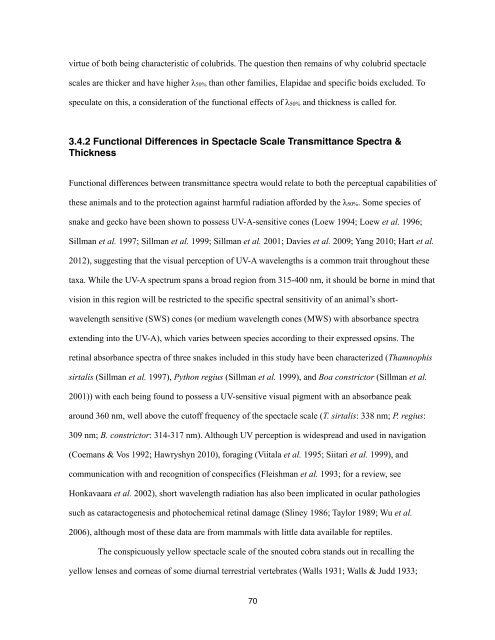Chapter 1, The Reptilian Spectacle - UWSpace - University of ...
Chapter 1, The Reptilian Spectacle - UWSpace - University of ...
Chapter 1, The Reptilian Spectacle - UWSpace - University of ...
Create successful ePaper yourself
Turn your PDF publications into a flip-book with our unique Google optimized e-Paper software.
virtue <strong>of</strong> both being characteristic <strong>of</strong> colubrids. <strong>The</strong> question then remains <strong>of</strong> why colubrid spectacle<br />
scales are thicker and have higher λ50% than other families, Elapidae and specific boids excluded. To<br />
speculate on this, a consideration <strong>of</strong> the functional effects <strong>of</strong> λ50% and thickness is called for.<br />
3.4.2 Functional Differences in <strong>Spectacle</strong> Scale Transmittance Spectra &<br />
Thickness<br />
Functional differences between transmittance spectra would relate to both the perceptual capabilities <strong>of</strong><br />
these animals and to the protection against harmful radiation afforded by the λ50%. Some species <strong>of</strong><br />
snake and gecko have been shown to possess UV-A-sensitive cones (Loew 1994; Loew et al. 1996;<br />
Sillman et al. 1997; Sillman et al. 1999; Sillman et al. 2001; Davies et al. 2009; Yang 2010; Hart et al.<br />
2012), suggesting that the visual perception <strong>of</strong> UV-A wavelengths is a common trait throughout these<br />
taxa. While the UV-A spectrum spans a broad region from 315-400 nm, it should be borne in mind that<br />
vision in this region will be restricted to the specific spectral sensitivity <strong>of</strong> an animal’s short-<br />
wavelength sensitive (SWS) cones (or medium wavelength cones (MWS) with absorbance spectra<br />
extending into the UV-A), which varies between species according to their expressed opsins. <strong>The</strong><br />
retinal absorbance spectra <strong>of</strong> three snakes included in this study have been characterized (Thamnophis<br />
sirtalis (Sillman et al. 1997), Python regius (Sillman et al. 1999), and Boa constrictor (Sillman et al.<br />
2001)) with each being found to possess a UV-sensitive visual pigment with an absorbance peak<br />
around 360 nm, well above the cut<strong>of</strong>f frequency <strong>of</strong> the spectacle scale (T. sirtalis: 338 nm; P. regius:<br />
309 nm; B. constrictor: 314-317 nm). Although UV perception is widespread and used in navigation<br />
(Coemans & Vos 1992; Hawryshyn 2010), foraging (Viitala et al. 1995; Siitari et al. 1999), and<br />
communication with and recognition <strong>of</strong> conspecifics (Fleishman et al. 1993; for a review, see<br />
Honkavaara et al. 2002), short wavelength radiation has also been implicated in ocular pathologies<br />
such as cataractogenesis and photochemical retinal damage (Sliney 1986; Taylor 1989; Wu et al.<br />
2006), although most <strong>of</strong> these data are from mammals with little data available for reptiles.<br />
<strong>The</strong> conspicuously yellow spectacle scale <strong>of</strong> the snouted cobra stands out in recalling the<br />
yellow lenses and corneas <strong>of</strong> some diurnal terrestrial vertebrates (Walls 1931; Walls & Judd 1933;<br />
70
















